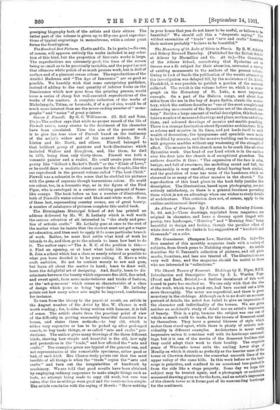George .7. Pinwell. By G. C. Williamson. (G. Bell and
Sons. 21s.)—The author says that while no proper record of the life of Pinwell exists, many stories to the detriment of his character have been circulated. Thus the aim of the present work is to give the true view of Pinwell based on the testimony of the artist's widow and of his nearest friends, Sir J. Linton and Mr. North, and others. Pinwell belonged to that brilliant group of painters and book-illustrators which included Walker and Houghton, and, like them, he died in 1S75, being then only thirty-three. Pinwell was both a romantic painter and a realist. He could create pure dreamy poetry like "Gilbert a Becket's Troth" or the "Elixir of Love," or he could draw a realistic street scene for the Graphic, like the one reproduced in the present volume called "The Lost Child." Pinwell was a colourist in the sense that he studded his pictures with the gems of separate though harmonious colour. He could use colour, too, in a dramatic way, as in the figure of the Pied Piper, who is enveloped in a curious swirling garment of flame- like orange. The book before us has a number of illustrations, both of Pinwell's water-colour and black-and-white work. Some of these last, representing country scenes, are of great beauty. A number of catalogues of pictures complete this useful book.
The Birmingham Municipal School of Art has printed an address delivered by Mr. W. R. Lethaby which is well worth the serious attention of all interested in "the study and prac- tice of artistic crafts." Mr. Lethaby goes at once to the root of the matter when he insists that the student must not get a vague art education, and then seek to apply it to some particular branch of work. Rather, he must first settle what kind of- work he intends to do, and then go to the schools to learn how best to do it. The author says :—" The A. B. C. of the position is this :— A. Find an opening, or at least what looks like an opening.
B. Join a school which has a class as nearly related as possible to what you have decided is to be your calling. C. Have a wide craft ambition. Do not be content merely to sew and gum, but learn all about the matter in hand ; learn to draw well, learn the delightful art of designing. And, finally, learn to dis- criminate between the beauty which expresses fine skill, fine mind, and sweet spirit, from mere make-believes and tricks of fashion, or the • art-gone-sour' which seems so characteristic of a class of design which poses as being 'up-to-date.' Mr. Lethaby points out how many minor arts might be improved, tombstones for instance.
To turn from the theory to the practical result, an article in the August number of the Artist by Mrs. W. Chance is well worth reading ; for, besides being written with humour, it is full of sense. The article starts from the practical point of view of the difficulty in getting reasonably beautiful furniture for a house, and states three methods,—to buy old, which is either very expensive or has to be picked up after prolonged search, to buy trade things, or so-called "arts and crafts" pro- ductions. The author gives many drawings of the three different kinds, showing how simple and beautiful is the old, how ugly and pretentious is the "trade," and how affected the "arts and crafts." The examples given are typical of the general run, and not representative of the remarkable specimens, either good or bad, of each kind. Mrs. Chance truly points out that the most terrible of all things is when the " trade " copies the "arts and crafts" and turn out the irregularities of handwork by machinery. We are told that good results have been obtained by employing ordinary carpenters to make simple things such as beds, no attempt being made to copy old work, but care was taken that the mouldings were good and the construction simple. The article concludes with the saying of Morris : "Have nothing in your house that you do not know to be useful, or believe to beautiful." We should call this a "desperate saying." The wildest enormities of "trade" and "arts and crafts" furnitto their makers probably "believe to be beautifuL"






































 Previous page
Previous page